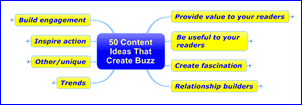 Whenever a blogger publishes a long list of tips, I can’t help but wonder what they would look like as a mind map. Recently, thanks to a message posted to Twitter, I learned of a particularly good list of web content “buzz builders” – topic types that are most likely to generate comments, tweets, diggs, links and other forms of attention – on the Conversation Agent blog. As a blogger, these ideas are of great interest to me. So I created a mind map of it (please click on the image above right to download a PDF version showing all 50 tips).
Whenever a blogger publishes a long list of tips, I can’t help but wonder what they would look like as a mind map. Recently, thanks to a message posted to Twitter, I learned of a particularly good list of web content “buzz builders” – topic types that are most likely to generate comments, tweets, diggs, links and other forms of attention – on the Conversation Agent blog. As a blogger, these ideas are of great interest to me. So I created a mind map of it (please click on the image above right to download a PDF version showing all 50 tips).
As I create these maps, an interesting phenemenon tends to happen: As I add each tip to my map, I start to notice topics that are related, that are connected to one another by broader meta-topics. I create first-level topics for each of these big categories, and then drag and drop related topics to it, positioning them as child topics.
Inevitably, by the time I reach the end of the list of tips, I have a few “orphans” – topics that don’t fit neatly into any of my first-level ideas. That forces me to reconsider my classification scheme, and may result in more re-shuffling and refactoring of topics until I’m satisfied that all of the tips have appropriate “homes.”
The result is a bit more useful than a long, undifferentiated linear list of tips. By categorizing them in a visual outline, you can now select ideas based on type. You may find as you look at this list that additional ideas pop into your head, as your powerful, incessantly creative mind forges new associations with the words and phrases in this map.
In closing, I urge you to think about this iterative process that I’ve just described, because it’s the type of process you ought to be following as you create your own mind maps. Don’t be afraid to move topics around and play “what if” with your map’s contents until you are satisfied with how they are arranged. That’s one of the keys to creating high quality, high impact mind maps!

Leave a Reply